 Nick has been playing hockey again this season. Note the left knee brace to protect his repaired ACL.
Nick has been playing hockey again this season. Note the left knee brace to protect his repaired ACL.
We went to watch his matches. His team didn’t play particularly well in the semifinal and won.
They played well in the Grand Final but lost.

In the end I had to take much advice from the fellow-members of “Western Thunder” – a model railway nerds website. I dismantled the tender and much of the running gear and made sure that all of the compensation mechanism was free to move. One suggestion had been to twist the chassis, but in the end I achieved much the same effect by introducing a spacer at one corner between the outer farm and the chassis, thus effectively applying a permanent twist to the latter.
The tender now runs:
However I realised that as it is the front wheels lifting off the track by 0.5mm, testing the tender on the S-shaped curve but with a dip in the track might not be good enough: the concavity of the track might keep the front wheels in contact when flat track or even a hump in the track might have the opposite effect and cause a derailment.
So instead I had to raise the centre of the test track and make the tender run over this. The only realistic way to do this is to pull it behind the locomotive! This became the first trial runs of the locomotive and completed tender:
It doesn’t run smoothly though – this is because there are electrical short-circuits created between the pony truck wheels and the front locomotive steps, and also between the guard irons on the tender (the metal posts which clear the rails of anything before the wheels run over it on the real thing). However the assembly never de-rails, which is a triumph!
Here is a picture of the whole assembly as it is now.
Now in some respects I am very pleased with my progress, but in other respects quite distressed and appealing for help!
I have finished the tender, with reservations – it doesn’t run as well as it should and needs to!
As you can see, i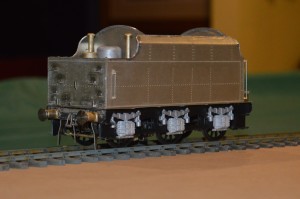 t looks OK (given that it isn’t painted).
t looks OK (given that it isn’t painted).
However even on my S-shaped test track it de-rails: there is a compensation mechanism which should allow there to be free movement of the rear four wheels almost independent of each other but this doesn’t seem to work completely effectively. If it did, the six wheels would all be always in contact with the rail. However the front axle seem to be able to have one rim off the rail, and so with the small S7 flanges, it de-rails. Adding weight to the front end of the tender makes no difference.
I had been so careful …. !
At every stage of construction I had run the tender chassis up and down behind the locomotive and it ran without problems. However at the some stage it becomes necessary to put it all together, take a deep breath and solder it up in such a way that it cannot be taken apart to adjust it.
By the time I had the water-scoop parts and the split-axle pick-up components all crowded together, it looks like this:
I dread having to unsolder it and take it all apart again!
It looks so good.
However looks aren’t everything, and unless additional lubrication of the moving parts frees up the mechanism and allows it to run over uneven track, what else can I do?
I visited England just before the referendum which was to see the UK population decide that they wanted to leave Europe (at least figuratively, although many would like it to be physical as well, I suspect). Whatever your politics are or your opinion on “Brexit”, I think it is safe to say that there will be a significant price that Britain and the EU will both pay for the vote in the short term. Whether there will be a long term benefit seems very uncertain, and that is why I did not believe the vote would be to leave.
Back to my UK visit.
I travelled with Etihad Airways, who are/are excellent. The Middle Eastern airlines are amongst the very best to travel with. Its just a pity that they come from such repressive counties. I was reading about the United Arab Emirates whilst I was away, and by flying with Emirates/Etihad/Qatar, a traveller is supporting a racist, evangelical, intolerant and unforgiving hierarchy in that country, I now realise. However Etihad gave me flights that were good. Lying flat makes such a difference, and I probably slept six hours between Sydney and Abu Dhabi. As part of the deal the airline provided a car to take me anywhere within a 100-miles-by-road of the arrivals hall. The driver took me to Sheffield! From Manchester the driver took a back route to avoid traffic which turned out very well for me. I picked up the SIM card for my ‘phone, but was without choice transferred by O2 (the provider) to a “Big Bundle” with 1000 “free” texts and 200 min. “free” talk time – but none for overseas calls! So the family could track me on Find My Friends, and could call me, but I couldn’t call them. Annoying.
I had a walk around Sheffield: it has so many signs of its old industrial past in once-magnificent, or at least very imposing buildings now in a derelict condition. Gosh they trashed the environment, or at least really didn’t care or understand the damage that was done. I started off on the “Five Weirs walk” but it turned out just to be through old polluted areas and I’d soon had enough and went elsewhere. Steve, Christine are well. Alarmingly for me, Steve will retire next year – how can I have friends who are old enough to retire? We went out walking around the reservoirs above Sheffield the following couple of days. Cold and windy but no rain.
The train over to Manchester was very crowded. I was lucky to get a seat. Train travel has become very popular, probably because the roads are so crowded. The authorities are repenting closed railways and even thinking about building new ones. So unlike the government in Sydney/NSW. I arrived early enough yesterday to be able to look around central Manchester, which actually is quite impressive now. Mainly because there are some very impressive Victorian architecture buildings. There is also a canal which runs through the middle! During the conference we had some lovely weather: blue sky and sunshine (in Manchester!). The long days are good also: daylight at 4am with the birds twittering outside is a mixed blessing, but daylight at 10pm is good, at least when the weather is nice. During the conference we had an hour’s talk from Alice Roberts (the TV personality and Professor of Embryology and Anatomy in Birmingham), and from a wildlife photographer! I like this conference innovation, and judging by the audience, lots of other people appreciated it also. I went out to eat at “The French” restaurant with John. Another restaurant by Simon Rogan (from l’Enclume – see entry from a couple of years ago) It was good, but seriously expensive.
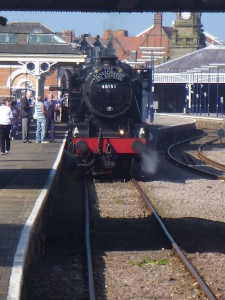 John arranged for us to go on the steam-hauled Scarborough Spa Express on Thursday, pulled by a Stanier 8F. We had a good day: Scarborough was more interesting than I had expected. It is mostly the Brits. demonstrating how to go on holiday and lose both your sense of value and any sense of good taste. There was a ridiculous boat made to look like a children’s pirate ship in which you could float around the harbour for a pound. The operator would have had to pay me to be seen in it, and pay me a lot of money. However there are also some interesting things to be seen – the castle is superb, and some of the buildings are worth a good look.
John arranged for us to go on the steam-hauled Scarborough Spa Express on Thursday, pulled by a Stanier 8F. We had a good day: Scarborough was more interesting than I had expected. It is mostly the Brits. demonstrating how to go on holiday and lose both your sense of value and any sense of good taste. There was a ridiculous boat made to look like a children’s pirate ship in which you could float around the harbour for a pound. The operator would have had to pay me to be seen in it, and pay me a lot of money. However there are also some interesting things to be seen – the castle is superb, and some of the buildings are worth a good look.
The train journey was good, traveling through beautiful countryside on a lovely day in springtime. The Vale of York is at its best at the moment. I managed to avoid fish and chips on the seafront. We ate nice salmon sandwiches and also crumbly Lancashire cheese ones, plus fresh orange and mango juice, all whilst we sat on the walls of Scarborough Castle.
We also saw Ann Bronte’s grave (she wrote The Tenant of Wildfell Hall – IMO the best Brontë novel), so it was worth going to pay tribute.
They inscribed the wrong age on her headstone!
The next day we went up to Cark and even though it absolutely poured down the next morning it couldn’t dampen my spirits: real Lake District weather. We went for a walk around the Cartmel Peninsula. It’s a lovely area, and shows the green of England at its best. That evening we went out to the Rogan & Co. restaurant, and it was very very good. I had a goats cheese-and-beetroot salad starter and sweetheart cabbage and roasted nuts for main course. John had pork belly as starter (what a surprise) and Goosenargh duck as main course (another surprise).
The next day we climbed Helvellyn.
Both John and I reached the summit. We chose a steep route up and a more gentle path down. Just as well, my knees couldn’t have taken a steep descent. It was a lovely day. I may even have been sunburnt in the north of England (well, OK, that’s a little of an exaggeration).
It was certainly hot work at times.
I lost my sole on the way up Helvellyn.
I lost my other sole on the way down, and by the time we had walked back to the car, the boots were beyond any thought of repair.
Off to Oxted the following day. It was grey and rainy there. Not the heavy rain that we had up north, though. Next day we went to Portsmouth, and it was a really good day.  We went around HMS Victory. Gosh the sailors of that age were small and had a tough life. There were lots of other interesting things to see in the Naval Dockyard: unfortunately the Mary Rose exhibition was closed, but there was HMS Warrior (the first iron-clad warship), lots of small sailing boats, other smaller ships, etc.
We went around HMS Victory. Gosh the sailors of that age were small and had a tough life. There were lots of other interesting things to see in the Naval Dockyard: unfortunately the Mary Rose exhibition was closed, but there was HMS Warrior (the first iron-clad warship), lots of small sailing boats, other smaller ships, etc.
Portsmouth itself is just a small town, the harbour itself quite interesting, and lots of UK naval ships there. GB cannot quite get used to the fact it fundamentally is just a small nation now. They are spending billions of dollars on two (two!) aircraft carriers despite the fact that they don’t actually have any aircraft that can fly off them. Yes, that is true ….
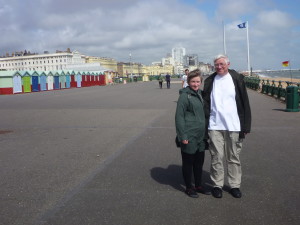 Then I visited Dave and Pauline in Hove: they are well. Dave is about to stop doing even the small amount of teaching and tutoring that he has been doing for Birkbeck College in order to concentrate on doing his PhD. He wants to change direction and become an academic lawyer: he’s certainly “paid his dues” as a criminal lawyer in Brixton! Pauline is working for another pressure group (“think tank”) in London, and both were campaigning to prevent England leaving the EU. No-one I talked to thought it was a good idea ….
Then I visited Dave and Pauline in Hove: they are well. Dave is about to stop doing even the small amount of teaching and tutoring that he has been doing for Birkbeck College in order to concentrate on doing his PhD. He wants to change direction and become an academic lawyer: he’s certainly “paid his dues” as a criminal lawyer in Brixton! Pauline is working for another pressure group (“think tank”) in London, and both were campaigning to prevent England leaving the EU. No-one I talked to thought it was a good idea ….
Next I went up to London to stay in a hotel called The Rookery. 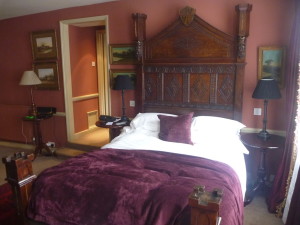 It is a quaint old-style building, but clearly with the intention of being a very upmarket hotel. A very unpretentious entry – basically you just ring the bell of what looks like a normal house (for this area, which of course is not really “normal” at all, given that it is in central London). Every room has the name of a local personage. Not necessarily an eminent person, though: two of the rooms are named after Victorian era prostitutes! My room. Is named after George Peacock, but the history doesn’t say much about him.
It is a quaint old-style building, but clearly with the intention of being a very upmarket hotel. A very unpretentious entry – basically you just ring the bell of what looks like a normal house (for this area, which of course is not really “normal” at all, given that it is in central London). Every room has the name of a local personage. Not necessarily an eminent person, though: two of the rooms are named after Victorian era prostitutes! My room. Is named after George Peacock, but the history doesn’t say much about him.
Staying in London was so that I could visit St Bartholemew’s Cardiac Unit. It is amazing. Three MR scanners just for cardiac work. One super-fast CT. Bart’s effectively is just a cardiac hospital now. Bart’s is near to StPauls Cathedral and also Smithfield Markets. It is an interesting area of London. Lots of bars, pubs, restaurants, but very few normal shops.
Off to Cambridge the next morning with Tim Elsworth for Christ’s College Alumni Garden Party. Cambridge has changed a lot over the years, and almost only the colleges themselves are recognizable, Tim and I decided. I knew very few people at the garden party, basically just Tim, Chris Cane and a guy called Mike Collinson, who used to cycle a lot, and once came to live in Sydney with his wife who was the Philippines’ ambassador for a while.
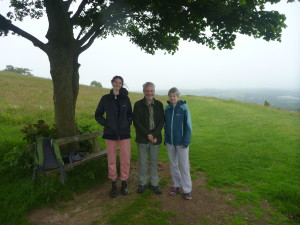 I then visited Amaryllis, Isobel and David, which was an excellent day out. They are well. Isobel is now at Leeds University reading Art History. We went for a walk over the South Downs, up to an Iron-Age fort, which was very interesting. It rained on us on the way back though. Well, it is England, after all!
I then visited Amaryllis, Isobel and David, which was an excellent day out. They are well. Isobel is now at Leeds University reading Art History. We went for a walk over the South Downs, up to an Iron-Age fort, which was very interesting. It rained on us on the way back though. Well, it is England, after all!
The final day, Mark and I went for a ride on the Bluebell Railway, partly because it is now an extension of the normal railway line through Oxted: we bought tickets at Oxted station and at East Grinstead we could essentially just walk along the platform to join the steam train going to Sheffield Park (the opposite end of the Bluebell Rly.). It was a lovely journey through the green English countryside of The Weald.
Both “boys” continue to play hockey – Nick in the local adult competition for Blaxland Rovers, Andrew for UNSW.
 Nick was playing today in Kingswood, so I took the opportunity to cycle down and watch him play. The “B Grade” competition may not be international standard, but it is still quite impressive to watch.
Nick was playing today in Kingswood, so I took the opportunity to cycle down and watch him play. The “B Grade” competition may not be international standard, but it is still quite impressive to watch.
Nick nearly scored a goal in the second half.
This is a sequence taken on “rapid fire” with the camera, as Nick ran forward with the ball (and then lost it to a defender).
I decided for some unknown reason to switch to the tender again. Perhaps because having succeeded with the brakes on the locomotive, I wanted to see if I could do them on the tender whilst the technique was still in my memory! So I measured the clearances, and found to my delight that no adjustment was really needed for ScaleSeven: the brake hangers could be soldered into the inner chassis frame and could be adjusted easily to be the correct clearance for the S7 wheels. Excellent. So I insulated the faces of the brake shoes as before, soldered the brake hangers and retried the running of the tender frames – it still works!
Next in the instructions is the water scoop lift gear. This proved to be a real challenge for me. There are times when I wish I was living in the UK (though not many ….) – the instruction sheet is really deficient in this section: “assembly is per diagrams and photos”; two unlabelled pictures and some difficult-to-decipher diagrams. It would have been much easier to be able to look at the real thing, but instead I had to look on the ‘net for drawings and pictures. It was almost too obscure even for the ubiquitous WWW: Google Images of “Stanier tender water scoop gear” produces almost no useful images! I eventually found some useful stuff – Some pictures of a model 3500 gallon LMS tender, and most useful were pictures of the Duchess and its tender in a Birmingham museum. I had to work out from their appearance what all the parts were for, and then how they go together. I hope I was right.
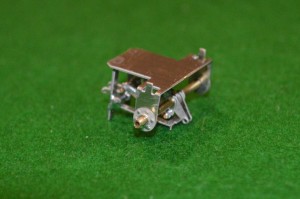 The mechanism is mounted under a crossmember of the tender chassis, and appears to be a rod or axle (moved by a long control beam from the front of the tender) on which a number of cranks are mounted. The ones at the rear end (right of photo. here) are aimed to lift the water scoop itself.
The mechanism is mounted under a crossmember of the tender chassis, and appears to be a rod or axle (moved by a long control beam from the front of the tender) on which a number of cranks are mounted. The ones at the rear end (right of photo. here) are aimed to lift the water scoop itself.
On the same axle are mounted levers which lower another device into the water troughs, the levers seen in the middle of the mech. and protruding to the left in the photo. below.
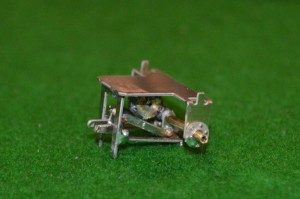
I’m not sure what this device did in real life – I guess that it was a deflector to channel more water from the edges of the water trough into the scoop?
There is also what I think must be a balance weight for the water scoop attached to the axle, seen in the middle of the mech. above (probably in the wrong position). I added to the thickness of the etched parts which represent this.
To make up the mechanism as seen above needed three parts to the frame (25 x 15 x 15mm), a piece of 1.6mm dia. rod, twelve tiny bits of etched nickel silver, half-a-dozen 1/32 brass pins and a HUGE amount of patience.
Some of the brake gear is also seen, but no water scoop as yet.
If my deductions were wrong about where everything goes, I’m not sure that I really want to know ….
Last weekend we visited some friends in Tasmania. As you might know, Tasmania produces some of the best sparkling wines in the world. So we had to try some.
We went on a superb walk around Cradle Mountain – 19km and up and down a couple of thousand metres, even though we didn’t attempt to get to the summit of the mountain itself!
It was seriously wet. The paths are good, and well-maintained in the National park. They needed to be!
The scenery was superb.
We also visited Low Head Lighthouse, at the mouth of the River Tamar, which has a huge compressed air powered foghorn, which has been restored and it powered up and sounded every Sunday. We were there at the right moment, and it was both deeply impressive and deafening!
Steam engines usually have two injectors to drive water into the boiler at high pressure. The Stanier 8F has an “Exhaust Steam Injector” on the right under the cab, and a “Live Steam Injector” on the left. The MOK kit has lost-wax castings of both, but the instructions are sketchy about how and exactly where to put them. When I looked at the engineers drawings, it became obvious that the live steam injector molding was incorrect. There should be four pipes coming off it or going to it. Water supply above the outgoing water to the boiler, on the inside surface, Live steam supply at the front, and overflow at the back. The MOK molding had four places for pipes, but two were on the side and two on the rear. In looking on the ‘net I had found illustrations of the injectors, and information that Laurie Griffin manufactures very good castings of both exhaust and live steam injectors, so I bought some by mail order.
When they arrived they were clearly a great improvement on the MOK ones in terms of detail, but the Laurie Griffin one was wrong also! The LG live steam injector only had three pipe fittings!
The LG one looks better, so I have used that one, fitting the overflow pipe to the bottom of the injector.
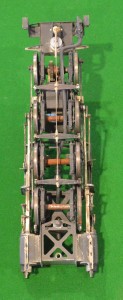 When I had put the exhaust steam injector onto the frames it involved fitting the steam pipe from the cylinders. It is difficult to form the reverse bend at the rear of the locomotive, and I hadn’t bent it quite correctly, leaving the pipe running at an angle down the frames.
When I had put the exhaust steam injector onto the frames it involved fitting the steam pipe from the cylinders. It is difficult to form the reverse bend at the rear of the locomotive, and I hadn’t bent it quite correctly, leaving the pipe running at an angle down the frames.
The Laurie Griffin exhaust injector molding includes last bend of this pipe, so it gave me an opportunity to correct this error.
However the injector comes in five pieces, which need to be soldered together, and then the four pipes have to be soldered onto the injector, without any of the other joints becoming un-soldered! It took me all day today, but here are the final results:
Click to enlarge. Clearly they have yet to go in place, but I might paint them first – it will be difficult after they are fitted. The Laurie Griffin exhaust steam injector (on the left in both pictures above) has exquisite detail, so I don’t want to mess it up with a poor paint job.
Delhi. The flights were good (Singapore Airlines), although the vegetarian meals were too spicy for me on the first flight. We spent some of my Singapore Dollars from our last trip there during our stopover. When we reached Delhi we were able to get to the hotel without any trouble: we were staying at a hotel which had a representative at the airport, who helped us find a taxi and directed the take to the correct destination – very fortunate. The drive was amazing: Delhi traffic is frenetic, crowded, noisy but amazingly good-tempered, it seems. The constant tooting horns aren’t irritation, but instead they are warnings just in case you’ve missed seeing the car 10 cm. behind or next to you, and I mean 10cm!
The hotel (The Leela Palace) was seriously grand and probably expensive, with the best buffet breakfast that I’ve ever had. I started with a Masala dhosa, but the Western breakfast items were just as good.
We found our way to the conference by taxi, registered, and went to talks. The lunch (included in the conference fee) was good also.
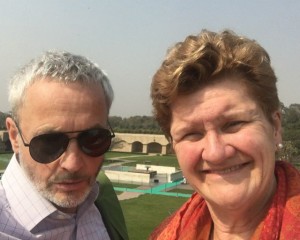 In the afternoon we saw India Gate and Mahatma Ghandi’s memorial site. Both were in their different ways very impressive. Delhi, though, fails to impress: the pollution is terrible, the streets filthy, there are lots of stray dogs, and lots of hassles from people desperate to sell you something that you don’t want.
In the afternoon we saw India Gate and Mahatma Ghandi’s memorial site. Both were in their different ways very impressive. Delhi, though, fails to impress: the pollution is terrible, the streets filthy, there are lots of stray dogs, and lots of hassles from people desperate to sell you something that you don’t want.
Off to Jaipur tomorrow.
Jaipur. We travelled by train from Delhi to Jaipur (my choice – against the advice of our Indian friends and to the surprise of the Mumbai-based travel agent).
Getting to New Delhi Railway Station at 0530 was the easy bit. Then we had to find where to go (easy, look for the train on the electronic board) and where to stand to get on the right coach. Not obvious on the platform. Back to the entrance. “Helpful” tout tells us our e-ticket isn’t valid, and we’ll have to go in his tuk-tuk to some other office, but he backs off when I start to ‘phone our travel agent. We go to the “International Travellers Help Desk”, which turns out to be a room with two people asleep on the couches. Someone else comes in (along with an Indian person guiding him) and wakes up one of the two scruffy people on the coaches, who turns out to be the official! After dealing with the other traveller, he eventually agrees our tickets are in order, but can’t explain to us how to find our coach and booked seats. We go back to the platform. The train is already there with 20 min. still to go. A dishevelled-looking man comes and sticks passenger names on dot-matrix printouts onto the coach sides. We find our coach and seats and get on with relief.
After that, the train journey was wonderful. Going slowly out through the suburbs, we see the appalling two-storey shanty towns by the railway tracks, some of them right on the tracks, with people waking up, washing (!) and getting dressed ON the tracks. These are “live” tracks, because further on we saw a moving goods train on the same line, moving slowly in the same direction as us, fortunately! Rubbish everywhere. This is a common theme of this trip, though: in the days when rubbish was paper and wood, it eventually degraded. Now it is mostly plastic. Later on, gradually the scene changes through the poor suburbs, the better ones, and then out into the country. Rajasthan is dry, dry, dry, flat, flat, flat. Until nearer to Jaipur, when small hills intermittently appear out of the flat landscape. A great journey.
Then we arrive in Jaipur Junction. Our driver greets us on the train: he gets onto the carriage and greets me by name.
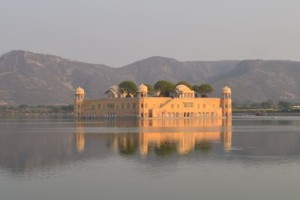 Our hotel is superb – See the picture from our window, looking over the Jal Mahal palace, which appears to float in the lake.
Our hotel is superb – See the picture from our window, looking over the Jal Mahal palace, which appears to float in the lake.
Alas, the vision is better than the personal experience: you cannot smell a picture. The lake is polluted and smelly. The water level is low (poor monsoons for three years) and there are colonies of rats burrowing into the banks by the road. We saw a local feeding them!
A slightly downside to the first day was the carpet-selling experience. It was an Third-World classic. Our driver takes us to a carpet factory where we are told how it employs all the local families, etc. [sympathy]; then we are given water bottle, and tea to drink [obligation]; “Sit down, and we will show you some of our (local) carpets” [play the local ideology card]. How much? Well, “we’ll quote in Australian dollars, and give you a good exchange rate” [but then charge your card in rupees – and it’s back to the banks’ rates]. Shipping and insurance is part of the price. Play one foreigner off against the other.
We bought a carpet anyway: Sue knew at the time that it was good value by Australian standards, although I did not of course, and was uncomfortable about the whole thing – to me it seemed very expensive, and I was aware of the potential scam, although Sue was also, of course.
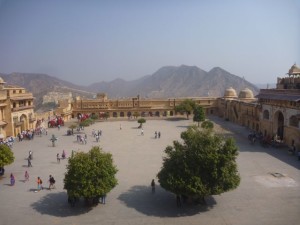 We next day we had a guide around Jaipur, who was very good. Took us to the Jaighur Fort and the Amber palace and fort, which were deeply impressive and often beautiful as well.
We next day we had a guide around Jaipur, who was very good. Took us to the Jaighur Fort and the Amber palace and fort, which were deeply impressive and often beautiful as well.
The bazaars are good (carpets excepted!). The palaces and museums excellent. The food really good. I had a stuffed paratha for breakfast this morning – really tasty.
Next, onto Pushkar.
Pushkar.
We set off from Jaipur this morning towards Udaipur. We had a planned stop at a town called Pushkar, about halfway from Jaipur to Udaipur.
We started off in traffic jams in Jaipur. It reminded us that Jaipur has nearly the same population as Sydney. Once out of Jaipur we were on motorway. Not the sort of motorway that you get elsewhere: after all, where else could you see someone shepherd a herd of goats across the motorway! Then we went off down a sideroad to visit our driver’s village, which was interesting.
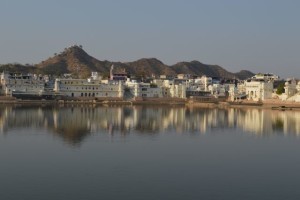 Pushkar turned out to be more interesting than I expected. A journey into the past, it was like going back to India or Nepal from the early 80s! More whiteys than we’ve seen all the rest of the trip put together, and in tie-die shirts (I’m not joking), John Lennon glasses and those stripy baggy trousers drawn in at the ankles which I’ve forgotten the name of. Incense sticks, multicoloured bangles and textured waistcoats on the market stalls. You might be getting the picture by now. Sue tells me that she saw a scruffy young western woman dressed in rags but who spoke with a plummy Home Counties accent. There’s even a Pink Floyd Cafe. Well, I Wish You Were Here to see it all, it’s quite extraordinary !
Pushkar turned out to be more interesting than I expected. A journey into the past, it was like going back to India or Nepal from the early 80s! More whiteys than we’ve seen all the rest of the trip put together, and in tie-die shirts (I’m not joking), John Lennon glasses and those stripy baggy trousers drawn in at the ankles which I’ve forgotten the name of. Incense sticks, multicoloured bangles and textured waistcoats on the market stalls. You might be getting the picture by now. Sue tells me that she saw a scruffy young western woman dressed in rags but who spoke with a plummy Home Counties accent. There’s even a Pink Floyd Cafe. Well, I Wish You Were Here to see it all, it’s quite extraordinary !
Onto Udaipur tomorrow.
Udaipur.
Well we are at our hotel in Udaipur now. Having said that Pushkar was like the 1980s (or 70s or 60s), this like going back to the 1930s! Shikarbadi Hotel used to be a maharajah’s hunting lodge/palace, and so is a hotel with a swimming pool, a stable (complete with thoroughbred polo ponies), a deer park, a polo field, and its own airport (complete with control tower)!
The worst thing so far is the noise of the monkeys on our roof. I just hope that they sleep well at night.
The journey down was pretty uneventful. The countryside around Udaipur is much less flat than around Jaipur, and looks much more fertile and productive.
Into Udaipur itself tomorrow.
We start at the Shikabadi hotel. Fortunately the monkeys also slept, until the morning climbing expedition over our roof.
The hotel is an art-deco tribute to the wealth of the maharanis (there a distinction between these and maharajahs, who are less warlike). The palace as it was has its own cricket pitch, polo field, stables, deer park, airport, and before the withdrawal of the princes’ privileges in 1971 it must have been the equivalent of any current millionaires country retreat anywhere.
Actually on the evening of our arrival the Marani of Mewar was having a friendly game of cricket on his pitch. He’d been brought there in his immaculately polished customised (Rokit-HC) white Range Rover. His personal staff were there, and although he looks just a ordinary guy (and was a very “ordinary” wicketkeeper), he clearly is NOT.
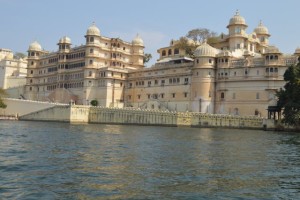 Today we went to the City Palace and Museum, which comprise the buildings seen in classic pictures of Udaipur. Actually the smart looking half is the 25-star hotel (10%) and the Maharani’s personal section (40%). The whole complex is both beautiful and deeply impressive. We also went on a boat ride to the Jagniwas Island (and around the five-star hotel made from the summer palace – another common picture of Udaipur). It really is a beautiful lake and surrounding scene.
Today we went to the City Palace and Museum, which comprise the buildings seen in classic pictures of Udaipur. Actually the smart looking half is the 25-star hotel (10%) and the Maharani’s personal section (40%). The whole complex is both beautiful and deeply impressive. We also went on a boat ride to the Jagniwas Island (and around the five-star hotel made from the summer palace – another common picture of Udaipur). It really is a beautiful lake and surrounding scene.
Tonight we will go out to eat at a lakeside restaurant. Lots of mosquito-repellent will be applied, I think!
Ambrai Restaurant was good, but mainly for its position: looking out over the main lake in central Udaipur. It is at water level, looking over to the City Palace and over to the Jag Mandir island with it snow-White luxury hotel. The main problem was getting there (and back): we had to walk along very narrow streets with tuk-tuks hurtling by, dogs, cows, and shop sellers hawking their wares. The return walk at 9pm was particularly trying.
The setting was superb, the food ordinary. The biryani just tasted like rice and vegetables, the other dishes almost just as bland. We’ll eat at the hotel tonight. We were advised against eating breakfast outside this morning because “there is a problem with monkeys”, but apparently they have gone by the time of an evening meal!
We went to Shilpgram Village outside Udaipur today. It is an area set up with typical houses from various parts of Rajasthan, with artists and craftsmen demonstrating and selling their wares. Needless to say, some items were secured for the new house, the Christmas tree (!), etc.
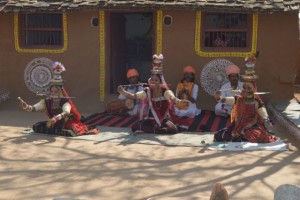 There were also some interesting dances, especially by the Devlas, but I couldn’t work out how to get the video on our Nikon SLR to work in time (simply pressing the red button didn’t seem to be enough!). Three young women swinging themselves around whilst holding knives between their teeth and balancing things on their heads!
There were also some interesting dances, especially by the Devlas, but I couldn’t work out how to get the video on our Nikon SLR to work in time (simply pressing the red button didn’t seem to be enough!). Three young women swinging themselves around whilst holding knives between their teeth and balancing things on their heads!
We then went back to Udaipur and wandered through the backstreets of the old part of town, much to our driver’s distress. He was clearly worried that we would either succumb to the wiles of an underhand shopkeeper, or be mugged! Fortunately neither happened, and we enjoyed a couple of hours just walking around. We bought nothing!
To the Monsoon Palace tomorrow, then we start home.
We are on our way home. I’m typing this in Udaipur Airport, having gone through security. Over an hour to wait for the flight to Delhi.
We’ve just said goodbye to the driver, Raju, who was with us since Jaipur. If you leave a gratuity/tip, what should it be? What is a reasonable amount to us creates distortion in the economy – if employers know employees are being given thousands they pay less and then when a tip is NOT given, the employee has worked for a pittance or for nothing – but to give what is a small amount to us (though good to the recipient) seems inadequate to the giver as a reflection of the service given. I don’t know the answer. Does anyone? Answers on a postcard, to ….
 We went to the Monsoon Palace this morning, perched on the top of the highest hill near Udaipur. Somewhat run down and dilapidated it is a good place to visit nevertheless. Great views over the area, and an interesting palace in itself. All the rainwater is carefully collected in vast tanks under the palace – because getting there, or getting anything like water there, is to struggle up a long, very tortuous road from Udaipur.
We went to the Monsoon Palace this morning, perched on the top of the highest hill near Udaipur. Somewhat run down and dilapidated it is a good place to visit nevertheless. Great views over the area, and an interesting palace in itself. All the rainwater is carefully collected in vast tanks under the palace – because getting there, or getting anything like water there, is to struggle up a long, very tortuous road from Udaipur.
After that we went to another textile shop. The remaining cash was “burning a hole in [Sue’s] pocket”, but we’ve managed to deal with that.
So, my impressions of India?
Firstly, Indians have so much to be proud of: the vibrant society, the incredible history, the people as a whole, the increasing belief that India is beholden to no-one and dependent on no-one. Yet there are problems: the Thatcher-like idea of wealth being generated at the top to trickle down to those below means that it would take centuries to reach those in the shanty towns by the railways; the pollution – everywhere is in a sort of haze, least noticeable in Udaipur, worst in Delhi of course; the half-hidden commissions and kickbacks that make me wary of anyone’s motives.
They are just like us (Aus. or Anglo.) and have a sense of humour. One of the guides asked me “what is heaven and what is hell”? I was looking for a Hindu definition when he continued on: “Heaven is an American salary, German car, Chinese food and an Indian wife. Hell is an Indian salary, a Chinese car, German food and an American wife.”
OK, I said a sense of humour, I didn’t qualify good, bad, etc., but it still distinguishes them from Americans, etc.
Andrew went to Nepal to visit a Nepalese hospital and some schools there. He also went to Pokhara, Nepal’s second city, and went paragliding over the lake, with an organisation saving birds of prey. To support their project, the organisation offers flights from Sarankot, and hill overlooking the lake at Pokhara, The drawcard is that they have trained some birds (Egyptian Vultures) to fly with them. Ostensibly the birds find the thermals, and as a reward for doing so, are fed scraps of meat by the pilots.
This is called “Parahawking” – perhaps para-vulturing doesn’t sound quite as attractive!
Still pictures are visible in our “Media” section of this site, for those with access.
YouTube videos are also available, click to view.